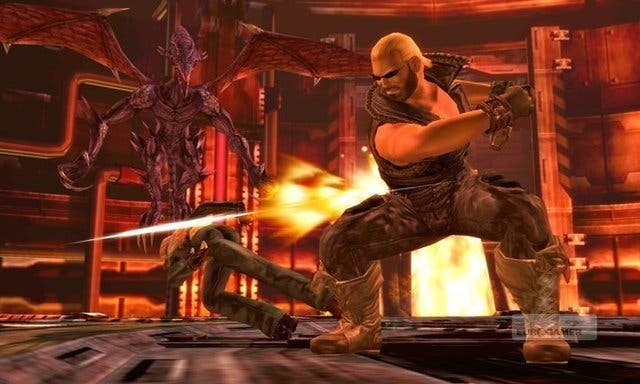Dead or Alive: Dimensions
3 double D.
Portable fighting games: to some they're an enjoyable time-sink with endless replay value; to others, they're a mechanically sound premise that's let down by frustrating controls. But while it's easy to whinge about d-pads and analogue sticks when you're dropping simple combos, when you consider the pocket fighter's progression in recent years, it's clear we've come a long way.
The PSP has near-flawless ports of Street Fighter Alpha 3, SoulCalibur IV and both Tekken 5 and 6, and with the advent of the 3DS, we can add a fully-fledged Super Street Fighter IV and BlazBlue: Continuum Shift II to the ever-growing list. But despite offering some of the richest fighting systems in portable form, few handheld fighters can match their console counterparts. Dead or Alive: Dimensions, however, is one that can.
Those unfamiliar with Dead or Alive may have heard about leather-bound ninjas, jiggly breast physics and extreme button mashing - and to be fair, most of these assumptions are entirely correct. But while DOA is considered to be less technical than Virtua Fighter or Tekken, it offers a precise fighting system that lets you punish predictable combos with ease. A DOA master will always trounce a DOA dabbler.
Dimensions is no exception, featuring a system that's based on Dead or Alive 4. But to make the flow of combat slightly less demanding, the counter system is borrowed from Dead or Alive 3. As such, there's no difference between countering punches and kicks as you simply counter by height - be it a low sweep to the shins, a sucker punch to the midriff or a high flying kick to the head.

A rock-paper-scissors dynamic also gives the fundamental techniques a clear strength and weakness. Strikes beat throw attempts, throws stuff up counters and well-timed counters turn the tables on striking momentum. It's classic Dead or Alive, and there's nothing like baiting your opponent into a predictable strike, only to answer with a galling counter that sends them ricocheting off an electrified wall.
However, this only covers the basics, as Dimension's flashiest combos are built around the Critical Stun and Launcher systems. These work by having certain moves that put your opponent into Critical Stun, and for every hit you land before they break free, the height of a follow-up launcher will be slightly increased.
This leads to freeform combos that require you to mix up your strikes so your opponent doesn't guess correctly and counter. And while that may sound baffling on paper, one of Dimensions' many triumphs is how it progressively teaches the full combat system through the Chronicle story mode.
The story is split between five Chapters that recount the canon plotlines of the main DOA games, and while you'll likely finish it in one sitting, it offers a ridiculous (but nonetheless entertaining) narrative that features hidden villages, multinational corporations and nefarious experiments. It's a retelling that focuses on the four main ninjas with everyone getting their moment in the spotlight - although for drunken master Brad Wong, this means showing up unexpectedly, trying to grope Ayane, getting beaten up by Hayate and then wandering off.

Chronicle mode also acts as a showcase for Dimensions' smooth graphics and seamless animations, and although it recycles a few FMV sequences from the series' history - including Hayabusa's ending from Dead or Alive 4 - the other cut-scenes are rendered with the in-game engine and use 3D for maximum effect. It's a convincing field of depth that puts most other 3DS games to shame. But once Chronicle mode is done and dusted, you'll likely turn the 3D off, as fights are best viewed at the standard 60 frames per second.
Another tricky decision comes courtesy of a select screen that offers every character from the series' 15 year history. This includes Jeet Kune Do doorman Jann Lee, wrestling actress Tina Armstrong, Sambo commando Bayman, karate high school student Hitomi and ninja siblings Kasumi, Ayane and Hayate.
Five unlockable bosses brings the character tally up to a fairly impressive 25, and although the game lacks original characters, a selection of new moves means series diehards will have plenty to discover. The main roster is also split between 11 men and nine women, making Dimensions one of the most sexually balanced fighting games ever.








